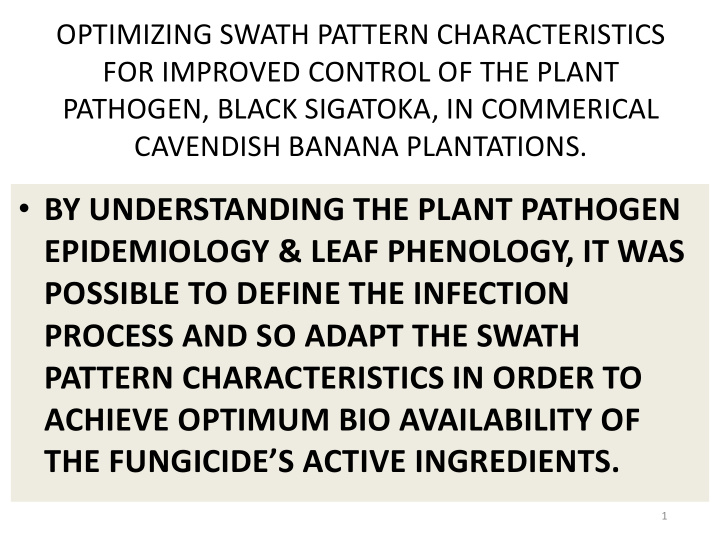



OPTIMIZING SWATH PATTERN CHARACTERISTICS FOR IMPROVED CONTROL OF THE PLANT PATHOGEN, BLACK SIGATOKA, IN COMMERICAL CAVENDISH BANANA PLANTATIONS. • BY UNDERSTANDING THE PLANT PATHOGEN EPIDEMIOLOGY & LEAF PHENOLOGY, IT WAS POSSIBLE TO DEFINE THE INFECTION PROCESS AND SO ADAPT THE SWATH PATTERN CHARACTERISTICS IN ORDER TO ACHIEVE OPTIMUM BIO AVAILABILITY OF THE FUNGICIDE’S ACTIVE INGREDIENTS. 1
BLACK SIGATOKA IS A PLANT PATHOGEN PANDEMIC ACROSS THE GLOBE- ÅFFECTINGI OVER 1,000,000 ACRES OF CAVENDISH BANANA PRODUCTION. RIGHT NOW- ON AVERAGE X50 AERIAL SPRAY APPLICATIONS ARE MADE TO KEEP THE DISEASE IN- CHECK, IF NOT, THE BANANA PLANTATION CAN BE DESTROYED WITHIN A MATTER OF MONTHS.
BANANA SPRAYING 3
THE IMPACT OF BANANA LEAF PHENOLOGY: HOW DOES THE LEAF SHAPE INFLUENCE FUNGAL SPORE & SPRAY DROP CAPTURE? 4
SIGATOKA DISEASE EPIDEMIOLOGY - FORECASTING- ACTIVE SPORE TRAPS
DISEASE INFECTION PATTERN 6
HOW IS IT POSSILBE THAT THIS CYLINDRICAL; VERTICAL LEAF CAN CAPTURE FUNGAL ASCOSPORES-15 µm
CP11 nozzle @ 60⁰ CP11 nozzle @ 30⁰ CP11 nozzle @ 0⁰
SWATHKIT ANALYSIS: DROPLET TECHNOLOGIES - USA 10
Turbo Thrush 32 CP11 TT VERTICAL : Droplet SIZE Distribution 9% 8% 0° Nozzle Angle 7% % DROP NUMBER 30° Nozzle Angle 6% 5% 4% 3% 2% 1% 0% DROP SIZE - microns Turbo Thrush 32 CP11 TT HORIZONTAL: Droplet SIZE Distribution 7% 0° Nozzle Angle 6% 30° Nozzle Angle % DROP NUMBER 5% 4% 3% 2% 1% 0% 11 DROP SIZE - microns
DROP SIZE DISTRIBUTION VERTICAL CYLINDERS DROPS > 400 NOZZLE ANGLE % NO. % VOL 0 3 30 30 1.6 10 HORIZONTAL DROPS 100 - 300 NOZZLE ANGLE % NO. % VOL 0 56 21 30 60 52 12
Turbo Thrush 32 CP11 TT VERTICAL : Droplet VOLUME Distribution 9% 8% 0° Nozzle Angle 7% 30° Nozzle Angle 6% % VOLUME 5% 4% 3% 2% 1% 0% DROP SIZE - microns Turbo Thrush 32 CP11 TT HORIZONTAL : Droplet VOLUME Distribution 10% 0° Nozzle Angle 9% 8% 30° Nozzle Angle 7% % VOLUME 6% 5% 4% 3% 2% 1% 0% 13 DROP SIZE - microns
VOLUME DISTRIBUTION VERTICAL CYLINDERS % VOL NOZZLE ANGLE DROPS < 300 0 47% 30 67% HORIZONTAL % VOL NOZZLE ANGLE DROPS > 450 0 75% 30 40% 14
Droplet cumulative distribution on the Vertical and Horizontal Collector: CP11 nozzle- 0⁰ vs. 30⁰ Turbo Thrush - CP11 - 4020 - 0° Turbo Thrush - CP11 - 4020 - 30° 100 100 90 90 Horizontal DV0.5 80 80 Horizontal DN0.5 Horizontal 70 70 Vertical DV0.5 DV0.5 Horizontal Vertical DN0.5 Cumulative % 60 Cumulative % 60 DN0.5 Vertical 50 50 DV0.5 Horizontal DN05 = 114µm 40 40 DV0.5 = 294µm Horizontal Vertical DN0.5 = 30 30 DN0.5 = 75µm 141 µ m DV0.5 = 261µm DV0.5 = 20 20 495 µ m Vertical 10 DN0.5 = 10 0 0 -100 100 300 500 700 900 0 100 200 300 400 500 600 700 800 900 Droplet Diameter (µm ) Droplet Diameter (µm ) APPENDIX 5 15
The results (R-Span) show quite clearly that a 30 Degree increase in nozzle orientation will has not caused any increase in the relative spectra spans so is NOT causing massive amounts of smaller drops! In terms of increased drift potential, under the correct conditions there will be no increase in drift by changing the Nozzle orientation from 0 to 30 degrees with the CP11 nozzle. 16
For Fungicides with a Protectant mode of action use a CP11 TT nozzle @ 30⁰ For Systemic Fungicides in an O/W tank mix use a CP11 TT nozzle @ 0⁰ 17
MICROEMULSION: HLD TECHNOLOGY 18
Recommend
More recommend